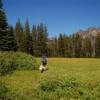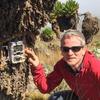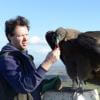Camera traps have been a key part of the conservation toolkit for decades. Remotely triggered video or still cameras allow researchers and managers to monitor cryptic species, survey populations, and support enforcement responses by documenting illegal activities. Increasingly, machine learning is being implemented to automate the processing of data generated by camera traps.
A recent study published showed that, despite being well-established and widely used tools in conservation, progress in the development of camera traps has plateaued since the emergence of the modern model in the mid-2000s, leaving users struggling with many of the same issues they faced a decade ago. That manufacturer ratings have not improved over time, despite technological advancements, demonstrates the need for a new generation of innovative conservation camera traps. Join this group and explore existing efforts, established needs, and what next-generation camera traps might look like - including the integration of AI for data processing through initiatives like Wildlife Insights and Wild Me.
Group Highlights:
Our past Tech Tutors seasons featured multiple episodes for experienced and new camera trappers. How Do I Repair My Camera Traps? featured WILDLABS members Laure Joanny, Alistair Stewart, and Rob Appleby and featured many troubleshooting and DIY resources for common issues.
For camera trap users looking to incorporate machine learning into the data analysis process, Sara Beery's How do I get started using machine learning for my camera traps? is an incredible resource discussing the user-friendly tool MegaDetector.
And for those who are new to camera trapping, Marcella Kelly's How do I choose the right camera trap(s) based on interests, goals, and species? will help you make important decisions based on factors like species, environment, power, durability, and more.
Finally, for an in-depth conversation on camera trap hardware and software, check out the Camera Traps Virtual Meetup featuring Sara Beery, Roland Kays, and Sam Seccombe.
And while you're here, be sure to stop by the camera trap community's collaborative troubleshooting data bank, where we're compiling common problems with the goal of creating a consistent place to exchange tips and tricks!
Header photo: Stephanie O'Donnell
No showcases have been added to this group yet.
Wildlife Conservation Society (WCS)
I am a biologist interested in land use change impacts on biodiversity and sustainable value chains. I work with productive sectors, incorporating biodiversity conservation as a criteria for planning and managing productive systems.
- 0 Resources
- 0 Discussions
- 4 Groups
British-Costa Rican | Interested in transdisciplinary research in Planetary Health amongst other things

- 0 Resources
- 1 Discussions
- 13 Groups
- @Rawail
- | Rawail
NbS Expert/ Environmentalist
- 0 Resources
- 0 Discussions
- 5 Groups
- @NinaTuttie
- | She
An avid learner interested in wildlife ecology, conservation technology and community development
- 0 Resources
- 0 Discussions
- 8 Groups
- @Tina
- | Her
I am a young researcher and scientist with extensive experience in the ecology of small mammals. I am open to career and capacity-building programs.



- 0 Resources
- 16 Discussions
- 6 Groups
- @shawnj
- | he/him
- 0 Resources
- 1 Discussions
- 1 Groups
Co-founder @ Behold
- 0 Resources
- 4 Discussions
- 6 Groups
- 0 Resources
- 0 Discussions
- 1 Groups
World Wide Fund for Nature/ World Wildlife Fund (WWF)

- 0 Resources
- 12 Discussions
- 15 Groups
Wildlife monitoring harmonizable at International level, Enetwild, European observatory of wildlife EOW, faunet, camera traps

- 0 Resources
- 2 Discussions
- 1 Groups
- @apcxs
- | He, his, them
- 0 Resources
- 0 Discussions
- 11 Groups
I am a software developer and marine conservationist, passionate about biodiversity conservation and sustainable living.
- 0 Resources
- 0 Discussions
- 1 Groups
This year's iWildCam competition is now live on kaggle. Go beyond just classifying species or detecting animals - this year the challenge focuses on counting how many individuals of each species are seen in a burst of...
12 March 2021
National Geographic is offering funding up to up to $50,000 for conservationists conducting research on how the pandemic has impacted wildlife and conservation work. If you are interested in researching aspects of the...
10 March 2021
Article
WildID is excited to share their new camera trap processing and detection tools with WILDLABS! Using machine learning to identify Southern African wildlife species in large quantities of camera trap data, WildID's tool...
8 March 2021
Based on one of the largest camera trap surveys ever attemped, Internet of Elephants' new mobile game Unseen Empire draws on the real field experiences and camera trap data sets of a single decade-long survey, giving...
8 March 2021
Article
Today we're celebrating the #Tech4Wildlife Photo Challenge by shining a spotlight on one of our favorite WILDLABS collaboration success stories: the BoomBox! This collaboration between Dr. Meredith Palmer, Jacinta ...
26 February 2021
Last year, Tim van Deursen and Thijs Suijten shared their new "Hack the Poacher" system with us, presenting a unique way to detect poachers in real-time within protected national parks. Read on to learn about their...
29 January 2021
In this case study from WWF's Northern Great Plains Program, Black-footed Ferret Restoration Manager Kristy Bly discusses how infrared FLIR cameras help teams detect and monitor the highly endangered black-footed...
19 January 2021
WILDLABS member Meredith Palmer shared this great course module based around Snapshot Serengeti camera trap data, and developed for university biology courses. This material is ideal for introductory level biology...
25 November 2020
Community Announcement
WILDLABS is celebrating its five year anniversary! Throughout the rest of 2020, we'll be sharing articles, community features, and case studies showcasing the incredible projects, collaborations, and successes that this...
17 November 2020
To celebrate the first Black Mammalogists Week (starting Sunday, September 13th), we talked to four of the amazing Black scientists behind this event! Find out what they had to say about their favorite (and most...
10 September 2020
Today, WWF conservation engineering intern Ashley Rosen shares insight into the process of redesigning a camera mount for FLIR thermal cameras used by rangers in the fight against poaching. Ashley's design will become a...
24 August 2020
Our first season of Tech Tutors may have wrapped, but the connections and collaborations from these episodes are still going strong! Today, we're sharing Tech Tutor presenter Laure Joanny's recap of the most important...
20 August 2020
August 2025
event
event
September 2025
event
event
event
May 2023
event
April 2023
58 Products
Recently updated products
4 Products
Recently updated products
| Description | Activity | Replies | Groups | Updated |
|---|---|---|---|---|
| Dear Anthony and Michal, Many thanks for the suggestions! Anthony, I have sent you a message through the site you linked to. I'd be interested to know more about the... |
+7
|
Camera Traps | 4 years ago | |
| Hi all, We're excited to welcome Siyu Yang to Tech Tutors to chat about getting started with Megadetector! For all you AI... |
|
AI for Conservation, Camera Traps, Data management and processing tools | 4 years ago | |
| I've been wondering about rangefinding/size-measuring technologies that could be incorporated into camera traps for a long time, and am following this thread and the work of @... |
|
Camera Traps | 4 years ago | |
| Thank you Stephanie, |
|
Camera Traps | 4 years ago | |
| Hi Doug. It's actually an interesting application, however it might actually be cheaper to try and put together an off-the-shelf solution rather than go custom. There... |
|
Camera Traps | 4 years 1 month ago | |
| That's such a cool list. Thanks for posting it! Akiba |
|
Camera Traps | 4 years 1 month ago | |
| Sharing this for COS4Cloud project. I am not part of the project. if you have questions, there are emails at the end for Alex and Angela... |
|
Camera Traps | 4 years 1 month ago | |
| Hi, Maybe try sourcing from Aliexpress? I an't speak to the quality, but at some price point it becomes worth looking into this option. -harold |
|
Camera Traps | 4 years 1 month ago | |
| Hi Michelle, I've worked on a few arboreal camera trap surveys so I might be able to share some information. With other researchers we've been working on a paper that... |
|
Camera Traps | 4 years 2 months ago | |
| I just did a quick search and it doesn't look like there's a place where you can ship them in Mexico. However, at least in Mexico City, there are a bunch of collection... |
|
Camera Traps, Latin America Community | 4 years 2 months ago | |
| Hello I understand how frustating that can be....I would try with the camera closer. 2.5m seem too far away for rat...specially that it must have some vegetation between. Also... |
+5
|
Camera Traps | 4 years 3 months ago | |
| Hi. Apparently it's a common problem with Spypoint cameras. I recommend checking out this thread and testing out the reboot procedure. Akiba |
|
Camera Traps | 4 years 3 months ago |
Resource: Wildlife Speed Cameras: Measuring animal travel speed and day range using camera traps
28 April 2016 2:39pm
7 August 2016 11:15pm
Hi Steph - just to follow up on your post: @MarcusRowcliffe , James Durrant and I have been working on a bit of software to implement the "computer vision" techniques that are mentioned in that paragraph. You can see a demonstration of it in action here. It requires camera-trappers to "calibrate" their camera traps during setup (or take-down), by taking pictures of a standard object (for example, we use a 1m pole held vertically) at different distances. The calibration takes ~10 mins per location. From this, you can reconstruct the paths that animals take infront of cameras, the total distance they travelled, and therefore their speed.
[ARCHIVED EVENT]: Approaches to Analysing Camera Trap Data
18 April 2016 3:45pm
5 August 2016 9:54pm
Hi Steph,
Only just discovered this site, so I'm a bit late to the game.
I'd love to hear what your main take-aways were from this meeting!
Best,
Louise
5 August 2016 10:35pm
Hi Louise,
Welcome! Unfortunately, an uncomfortably busy calendar meant I ended up missing this gathering. However, I'm sure that @SteffenOppel @Tomswinfield or @ali+johnston (I think you were all involved?) might be kind enough to jump in here and share some of their key take aways from this discussion?
Steph
How can technology help us monitor those small cold-blooded critters that live in caves?
25 July 2016 12:00am
Discussion: 360° Camera for Arboreal Camera Trapping
19 July 2016 2:38pm
Camera traps reveal mysteries of nature
18 July 2016 12:00am
Discussion: Self-powered camera trap
24 November 2015 7:36pm
1 December 2015 6:27pm
I was initially thinking of dozens or maybe even hundreds of nodes coming back to a central wired connection point. I wonder if something like Google's project Loon could work in place of an on-the-ground network.
But stepping back from the tech for a moment, really the problem we're trying to solve here is being able to have remote monitoring cameras that don't need anyone to go out to change batteries or memory cards. After salaries, vehicles/transportation is the top expense at pretty much all of the conservation partners we have. Anything we can do to reduce the travel (and the time of the people as well) is huge.
1 December 2015 6:37pm
So, in terms of power, does the "classic" solution with a set of solar panel cells on top of the box have some major flaws? I'm pretty sure I've seen self-powered meteo stations looking like this positioned along motorways/higways (don't remember what country or even a continent was it :-) Not being an expert in photo-voltaics, I would risk saying that a purposely-designed cell pointing up, directly at the sun, will have better efficiency than a re-purposed CMOS censor :-)
And indeed, talking to something overhead (either the baloons or Facebook's drones - forgot the name - or maybe even satellites?) would be probably much simpler than ground-based communication. If we had big enough energy budget, the communication channel would be "relatively easy" to implement...
4 July 2016 11:51am
Some camera trap manufacturers offer solar power as an add-on or option off the shelf. I agree that using the image seems like a solution looking for a problem.
The Highs and Lows of Camera Traps for Rapid Inventories in the Rainforest Canopy
4 July 2016 12:00am
Wildlife Crime Tech Challenge Accelerator Bootcamp
24 June 2016 12:00am
Project Feedback Wanted: Building Low Cost Cameras
2 March 2016 9:59am
11 May 2016 6:27pm
thanks for this very interesting post! i was also trying to develop an inexpensive camera trap but with not good results. i think the use of a PIR sensor can give more battery life than motion detection via software. Can you give more details about the components you used please?
Thanks
Paolo
20 May 2016 11:07pm
Hi Sorry been away, I'll list more about parts etc.. In the mean time the Pi Zero has just had an upgrade..
http://petapixel.com/2016/05/19/5-raspberry-pi-zero-now-camera-compatible/

TEAM Network and Wildlife Insights
28 April 2016 12:00am
Is Google’s Cloud Vision useful for identifying animals from camera-trap photos?
20 April 2016 12:00am
Disruptive Technology: Embracing the Transformative Impacts of Software on Society
10 March 2016 12:00am
[ARCHIVED]: Smithsonian Course: Camera Trapping Study Design and Data Analysis for Occupancy and Density Estimation
3 February 2016 2:25pm
Wildlife Crime Tech Challenge: Winners Announced!
22 January 2016 12:00am
The Social Lives of Conservation Technologies and Why They Matter
2 November 2015 12:00am










































13 June 2016 4:59pm
Here's a set of tools that could be applicable to this idea
https://github.com/pfr/VideoSpeedTracker